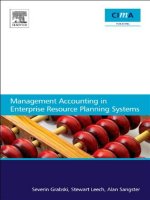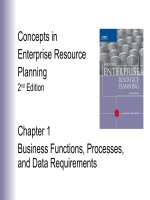Concepts in enterprise resource planning 4th marketing information systems ch03
Bạn đang xem bản rút gọn của tài liệu. Xem và tải ngay bản đầy đủ của tài liệu tại đây (919.84 KB, 55 trang )
Concepts in Enterprise
Resource Planning
Fourth Edition
Chapter Three
Marketing Information Systems and the
Sales Order Process
Objectives
After completing this chapter, you will be able to:
• Describe the unintegrated sales processes of the
fictitious Fitter Snacker company
• Explain why unintegrated Marketing and Sales
information systems lead to company-wide
inefficiency, higher costs, lost profits, and customer
dissatisfaction
• Discuss sales and distribution in the SAP ERP
system, and explain how integrated data sharing
increases company-wide efficiency
Concepts in Enterprise Resource Planning, Fourth Edition
2
Objectives (cont’d.)
• Describe how SAP ERP processes a standard
sales order
• Describe the benefits of customer relationship
management (CRM) software
Concepts in Enterprise Resource Planning, Fourth Edition
3
Introduction
• Fitter Snacker (FS)
– Fictitious company that makes healthy snack bars
– Does not have an integrated information system
• Marketing and Sales (M/S) is the focal point of
many of FS’s activities
• FS’s M/S information systems are not well
integrated with company’s other information
systems
– Company-wide use of transaction data is inefficient
Concepts in Enterprise Resource Planning, Fourth Edition
4
Overview of Fitter Snacker
• Manufactures and sells two types of nutritious
snack bars:
– NRG-A: “advanced energy”
– NRG-B: “body building proteins”
• Has organized its sales force into two groups,
known as divisions:
– Wholesale Division
– Direct Sales Division
Concepts in Enterprise Resource Planning, Fourth Edition
5
Overview of Fitter Snacker (cont’d.)
• The two sales divisions differ in terms of quantities
of orders and pricing terms
• Sells snack bars under the Fitter Snacker brand
name
• Packages the bars in store-brand wrappers for
some chain stores
Concepts in Enterprise Resource Planning, Fourth Edition
6
Problems with Fitter Snacker’s Sales
Process
• Many of Fitter Snacker’s sales orders have
problems, such as:
–
–
–
–
Incorrect pricing
Excessive calls to the customer for information
Delays in processing orders
Missed delivery dates
Concepts in Enterprise Resource Planning, Fourth Edition
7
Problems with Fitter Snacker’s Sales
Process (cont’d.)
• Reasons for problems:
– FS has separate information systems throughout the
company for three functional areas:
• Sales order system
• Warehouse system
• Accounting system
– High number of transactions that are handled
manually
– Information stored in the three systems is not
available in real time
Concepts in Enterprise Resource Planning, Fourth Edition
8
Problems with Fitter Snacker’s Sales
Process (cont’d.)
Figure 3-1 The sales process
Concepts in Enterprise Resource Planning, Fourth Edition
9
Sales Quotations and Orders
• Giving a customer a price quotation and then taking
the customer’s order at FS
– Sales call: salesperson either telephones the customer
or visits in person
– At the end of sales call, salesperson prepares a
handwritten quotation on a form that generates two
copies
• Original sheet goes to the customer
• Middle copy is first faxed and then mailed to the sales
office
• Salesperson keeps the bottom copy for his or her records
Concepts in Enterprise Resource Planning, Fourth Edition
10
Sales Quotations and Orders (cont’d.)
• Giving a customer a price quotation and then
taking the customer’s order at FS (cont’d.)
– Quotation form has an 800 number that the
customer can call to place an order
• Problems can occur with this process
• Inefficiencies in the rest of the ordering process
– Determining the delivery date
– Checking customer’s credit status
– Entering customer’s order into the current order
entry system
Concepts in Enterprise Resource Planning, Fourth Edition
11
Order Filling
• Packing lists and shipping labels
– Printed twice a day
– Hand-carried to the warehouse
– At warehouse, hand-sorted into small orders and
large orders
• Warehouse
– Small-order packing area
– Large-order packing area
• FS uses a PC database program to manage
inventory levels in the warehouse
Concepts in Enterprise Resource Planning, Fourth Edition
12
Order Filling (cont’d.)
• FS keeps inventory levels fairly low, and inventory
levels change rapidly during the day
– Picker might go to the shelves to pick an order and
discover that there are not enough of the desired
type of snack bars to fill the order
– To determine what to do in this situation, order picker
might have conversations with warehouse
supervisor, production supervisor, and sales clerks
Concepts in Enterprise Resource Planning, Fourth Edition
13
Accounting and Invoicing
• Invoicing the customer is problematic
• Sales clerks send the Accounting department the
sales order data for customer invoices
• Accounting department loads the data into PCbased accounting program
• Clerks manually make adjustments for partial
shipments and any other changes
• Sometimes, order corrections are delayed and
don’t catch up to the invoicing process
– Results in late or inaccurate invoices
Concepts in Enterprise Resource Planning, Fourth Edition
14
Payment and Returns
• Problems with procedure for processing payments
– If any errors have occurred in the sales process,
customer will receive an incorrect invoice
– Many customers don’t return a copy of the invoice
with their payment; errors can result
Concepts in Enterprise Resource Planning, Fourth Edition
15
Payment and Returns (cont’d.)
• FS’s returns processing is flawed
– Many customers do not call for the RMA number, or
fail to include it with their returned material
• Makes it more difficult for Accounting department to
credit the appropriate account
– Poor penmanship on the returned material sheet can
create problems for Accounting
• If a customer’s account has not been properly
credited, customer may receive a dunning letter in
error
Concepts in Enterprise Resource Planning, Fourth Edition
16
Sales and Distribution in ERP
• ERP systems can minimize data entry errors and
provide accurate information in real time to all
users
• ERP systems can track all transactions (such as
invoices, packing lists, RMA numbers, and
payments) involved in the sales order
Concepts in Enterprise Resource Planning, Fourth Edition
17
Sales and Distribution in ERP (cont’d.)
• SAP ERP Sales and Distribution module treats the
sales order process as a cycle of events:
–
–
–
–
–
–
Pre-sales activities
Sales order processing
Inventory sourcing
Delivery
Billing
Payment
Concepts in Enterprise Resource Planning, Fourth Edition
18
Pre-Sales Activities
• Customers can get pricing information about the
company’s products:
– Through an inquiry or a price quotation
• Marketing activities such as tracking customer
contacts, including sales calls, visits, and mailings
• Company can maintain data about customers and
generate mailing lists based on specific customer
characteristics
Concepts in Enterprise Resource Planning, Fourth Edition
19
Sales Order Processing
• Sales order processing: series of activities that
must take place to record a sales order
• Sales order can start from a quotation or inquiry
generated in the pre-sales step
• Information collected from the customer to support
the quotation is immediately included in sales order
• Critical steps in sales order processing:
– Recording the items to be purchased
– Determining the selling price
– Recording the order quantities
Concepts in Enterprise Resource Planning, Fourth Edition
20
Sales Order Processing (cont’d.)
• Users can define various pricing alternatives in the
SAP ERP system
• SAP ERP system checks the Accounts Receivable
tables in the SAP ERP database to confirm the
customer’s available credit
• If customer has sufficient credit available
– Order is completed
• If customer does not have sufficient credit available
– SAP ERP system prompts sales personnel to take
one of the possible appropriate actions
Concepts in Enterprise Resource Planning, Fourth Edition
21
Inventory Sourcing
• Available-to-Promise (ATP) check
– SAP ERP system checks company’s inventory
records and production planning records to see
whether:
• Requested material is available
• Requested material can be delivered on the date the
customer desires
– Includes expected shipping time
• System can recommend an increase in planned
production if a shortfall is expected
Concepts in Enterprise Resource Planning, Fourth Edition
22
Delivery
• Delivery in SAP ERP system
– Releasing the documents that the warehouse uses
to pick, pack, and ship orders
• Delivery process allows deliveries to be created so
that the warehouse and shipping activities are
carried out efficiently
• Once the system has created documents for
picking, packing, and shipping, documents are
transferred to Materials Management module
Concepts in Enterprise Resource Planning, Fourth Edition
23
Billing
• SAP ERP system creates an invoice by copying
sales order data into the invoice document
• Accounting can print this document and mail it, fax
it, or transmit it electronically to the customer
• Accounting records are updated at this point
Concepts in Enterprise Resource Planning, Fourth Edition
24
Payment
• When the customer sends in a payment, it is
automatically processed by the SAP ERP system
– Debits cash and credits (reduces) customer’s
account
• Timely recording of this transaction has an effect
on the timeliness and accuracy of any subsequent
credit checks for the customer
Concepts in Enterprise Resource Planning, Fourth Edition
25









